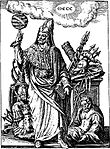| Part of a series on |
| Hermeticism |
|---|
 |
The Cyranides (Greek: Κυρανίδες; also Kyranides or Kiranides) is a compilation of ancient Greek works on magic and medicine first put together in the 4th century.[1] Latin and Arabic translations also exist. It has been described as a "farrago" and a texte vivant,[2] owing to the complexities of its transmission: it has been abridged, rearranged, and supplemented. The resulting compilation covers the magical properties and practical uses of gemstones, plants, and animals, and is a virtual encyclopedia of amulets;[3] it also contains material pertinent to the history of western alchemy,[4] and to New Testament studies, particularly in illuminating meanings of words and magico-religious practices.[5] As a medical text, the Cyranides was held in relatively low esteem even in antiquity and the Middle Ages because of its use of vernacular language and reliance on lore rather than Hippocratic or Galenic medical theory.[6]
In the Pseudodoxia Epidemica, Thomas Browne described the Cyranides as "a collection out of Harpocration the Greek and sundry Arabick writers delivering not only the Naturall but Magicall propriety of things."[7] Although the Cyranides was considered "dangerous and disreputable" in the Middle Ages, it was translated into Latin by Pascalis Romanus, a clergyman with medical expertise who was the Latin interpreter for Emperor Manuel I Komnenos. The 14th-century cleric Demetrios Chloros was put on trial because he transcribed magical texts, including what was referred to as the Coeranis.[8]
- ^ David Bain, "περιγίνεσθαι as a Medical Term and a Conjecture in the Cyranides," in Ethics and Rhetoric: Classical Essays for Donald Russell on His Seventy-Fifth Birthday (Oxford: Clarendon Press, 1995), p. 283 online. Christopher A. Faraone, Ancient Greek Love Magic p. 121, dates the work to the 1st century.
- ^ French, "living text"; that is, an "open" document or text undergoing continuing revision by multiple hands and existing in no one authoritative form; see Wikipedia.
- ^ Faraone, Ancient Greek Love Magic, pp. 11 and 121.
- ^ David Bain, "Μελανῖτις γῆ in the Cyranides and Related Texts: New Evidence for the Origins and Etymology of Alchemy," in Magic in the Biblical World: From the Rod of Aaron to the Ring of Solomon (T&T Clark International, 2003), pp. 209–210, especially note 64.
- ^ Jeffrey B. Gibson, Temptations of Jesus in Early Christianity (Continuum International Publishing, 2004), p. 246 online; used as a source by James A. Kelhoffer, The Diet of John the Baptist: "Locusts and Wild Honey" in Synoptic and Patristic Interpretation (Mohr Siebeck, 2005), passim.
- ^ Maria Mavroudi, "Occult Science and Society in Byzantium: Considerations for Future Research," University of California, Berkeley, p. 84, full text downloadable.[dead link]
- ^ As cited by Bain, "Μελανῖτις γῆ," p. 208.
- ^ Bain, "Μελανῖτις γῆ," p. 208, note 61; Mavroudi, "Occult Science and Society in Byzantium," p. 84.